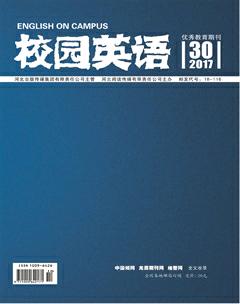An analysis of the Implications in Hills like White Elephants
梁宇雁
【Abstract】Ernest Miller Hemingway, American short story writer, is famous for his Iceberg theory. Hemingway advocates the writing principle of economy and understatement. Therefore, the symbolism of every settings and objects in this story will be of vital importance. Hills like White Elephants represents his economical and understated writing style. Because of this writing style, the story offers little information about background and appearance of the characters. Thus, that is not easy for readers to understand what the story tells. Therefore, this thesis aims to analyze the implications and predict the ending.
【Key words】symbolism; white elephants; names; dialogues
“Hills like white elephants” appears across the story, as well as being title of this short story. In the story, “The girl was looking off at the line of hills. They were white in the sun and the country was brown and dry.” and she thinks “they look like white elephants.” But the story happens in a very hot day. How come hills like white elephant without snow? In ancient India, “white elephant” was the noblest animal, while raising it requires high cost, so “white elephant” represents those unnecessary but precious gifts. Thus, Jig refers “white elephant” to her boyfriend many times could be a hint to the baby. The American views this baby as a “white elephant”. For him, this unexpected baby will be an obstruction between Jig and himself. Although this baby is precious, it definitely will change their lives, from free life to a settled one. As for Jig, she says the hills like white elephant, viewing this unborn baby as a burden. Later, Jig says that her observation that the hills dont really look like white elephant, which indicate the subtle change of her mind, she wants to keep the baby. Besides, hills like white elephant look like the swollen breasts and belly of a pregnant woman. Jig mentions this kind of hills many times, in order to appeal mans attention and she wants to discuss this unborn baby with her boyfriend by using this indirect way.
As for the protagonist names, the author selects elaborately. Jig is an only named person in the story. In the English slang “the jig is up”, it means all over, with no hope. “Jig” is original from a quick dance. It is ironic. On one hand, Jig represents those young and unsettled women. On the other hand, it indicates the relationship between Jig and her boyfriend will be changed because of her unexpected pregnant;they might be break up at the end. As for Jigs boyfriend, by giving the board appellations as “The America” and “the man”, the author means this man represents those young men, a loss generation on after the World War. They pursue free life and enjoy the unsettled life, which means this kind of man is unwilling to have a baby and form a family. All in all, “Jig” and “The America” have their symbolic meaning.endprint
Although Hemingway does not mention the mans name, he does mention the alcohols name, which is definitely meaningful. The first ordered drink is “Arus del Toro”, a drink tastes like licorice. Licorice has double taste and double nature: both sweetness and bitterness. This represents life is like licorice: before Jigs pregnancy, life is easy for Jig and the man. They lead a free life and everything goes toward their willing without any hesitation. While with the appearance of this unborn baby, life becomes hard for them, they have to make a decision and choose their lifestyle. As the girl says, “Everything tastes of licorice. Especially all the things youve waited so long for, like absinthe.” By saying this, Jig means everything at this stage is bitter. And every moment she hesitates makes she feels bad.
The story happens in Spain, a foreign place for Jig and the man. Jig does not know Spanish by saying “What does it say?” pointing at a drink. The man knows the Spanish, and be more familiar with the traveling place. Hemingway sets this environment in an unfamiliar place, in order to express the loss feeling of Jig, which means she has to depend on this nameless, faceless man. From Barcelona to Madrid, a foreign locality makes readers feel Jigs strange, loss and hesitation.
In the end of the story, Hemingway gives us an open ending. There are three possibilities between them: Jig will have the abortion and stay with the man; Jig will have abortion and leave the man; Jig will not have abortion. The second interpretation has the acceptance of many readers.
Hemingway lets the omniscient reader obtain a “wide-angle” view of the concluding scene in its tragic entirety. Using Iceberg theory, clear and short words makes every detail of this story more valuable.endprint

